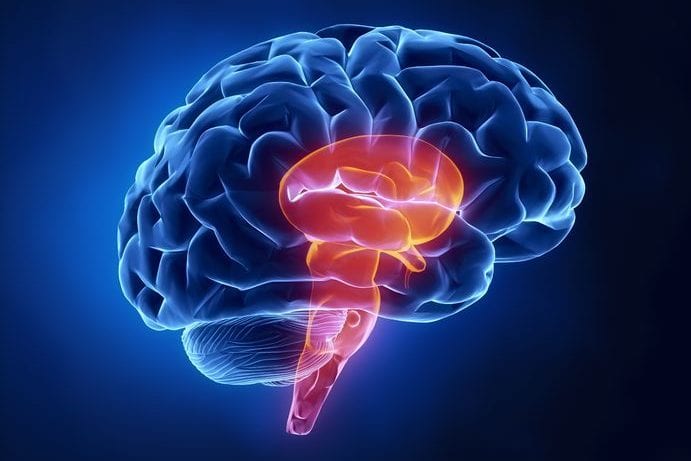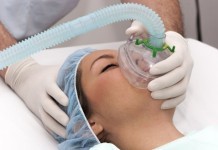The physical exam of the brain and nervous system can be broken down into two parts: the lumbar puncture and everything else.

Lumbar Puncture
The lumbar puncture (LP) or spinal tap (11) is extremely helpful for diagnostic purposes whether or not the results are positive. It is also a noninvasive procedure if you don’t factor in all the needles and stuff. We won’t go into the details of how to perform a lumbar puncture, but we will remind the reader of three things: (1) use landmarks, (2) observe sterile technique, and (3) insert needle with running start. Some will argue that this is not part of the neurologic exam. I would argue that they are probably correct.
General Appearance
What is the patient’s level of consciousness? Is it a coma and if so, is it the worst kind: a food coma? Is he or she altered or old? If the patient is altered, treat for UTI (urinary tract infection). If the patient is old, consult social services for placement. If the patient is both altered and old, consult palliative care before it’s too late.
Mini Mental Status Exam (MMSE)
The MMSE assesses cognitive impairment by focusing on attention, recall, language, attention, recall, and did I say attention? It takes no more than ten minutes to perform. Since that is exactly six-hundred seconds more than any health care practitioner can reasonably dedicate. This is where a medical student is most helpful.
Cranial Nerve Exam
For this part of the physical exam, shine a light into their eyes and have them follow your finger. (It is absolutely crucial to choose the correct finger.) Ask them to smile, puff their cheeks, keep their eyes closed, swallow, and sing. Use a tongue depressor to make them gag, urinate, and fart. Have them shrug their shoulders, turn their heads, drop their pants, and cough. I’m not sure how all these maneuvers assess the cranial nerves, but trust me: they do.
Motor Exam
The motor part of the physical exam assesses muscle tone, muscle strength, and involuntary movements. Observe any tics, tremors, and fasciculations, whatever fasciculations are. Then using Simon Says, speak commands and rate the strength of muscle groups on a scale from 0 to 5.
0 – No muscle contraction observed
1 – Strongly disagree
2 – Disagree
3 – Neither disagree or agree
4 – Agree
5 – Strongly agree
Discharge any patients who move without you saying “Simon Says.”
Sensory Exam
This part of the physical exam includes but is not limited to the evaluation of pain, light touch, and position with the use of tuning forks, regular forks, pins, whips, and chains. It can be erotic, particularly if the patient is handcuffed to the examination table with a safe word. By touching corresponding parts of the body and having the patient compare sensations, you will quickly determine that you can’t remember your sensory dermatomes. If you do not have access to a dermatome map, have a neurologist with an art degree paint them onto your patient.
Deep Tendon Reflexes
I call this part of the exam Hammer Time. A regular hammer is preferable since a rubber hammer blunts the reflex. (Note: When performing Hammer Time, stand to the patient’s side in order to avoid evaluation of one’s own cremasteric reflex.) Assess reflexes in four extremities, five if you’re feeling lucky, and rate them accordingly:
0 – True
1 – False
2 – Maybe
Complete this section by tickling the patient. If the patient’s reflex is laughter or incontinence, then the patient is normal. If not, it’s probably cancer.
Coordination & Gait
Though there are numerous ways to evaluate rapid alternating movements on physical exam, I prefer the 5 D’s: Dodge, Duck, Dip, Dive, and Dodge. The inability to perform them is called dysdiadochokinesis and is worth 99 Scrabble points if you can land it on a Triple Word Score. Likewise, there are numerous ways to assess gait. Tandem gait is useful, but I ask the patient to walk like an Egyptian. If I’m extremely suspicious, I’ll have the patient do a silly walk.
Pronator Drift
Have the patient stand erect, arms fully extended with palms facing upward. With the patient’s eyes closed, ask if he or she believes in pronator drift.
Romberg Test
The final maneuver is called the Romberg Test, which is named after a parallelogram with equal sides. Have the patient stand erect with eyes closed and arms to sides. The Romberg Test is positive if the patient falls over while you’re in another room typing notes.
More Physical Exam Tips below:
– The Heart
– The Lungs
– The Abdomen
– The Eye







